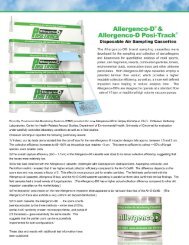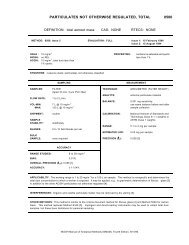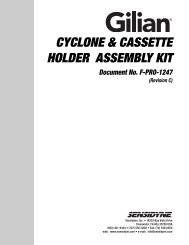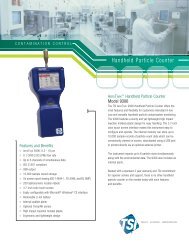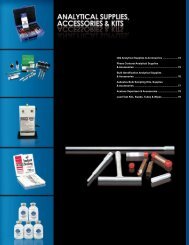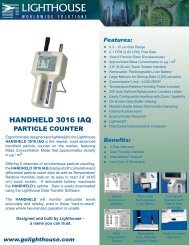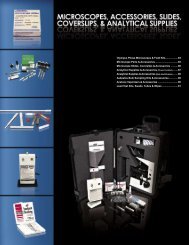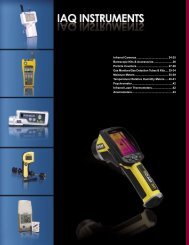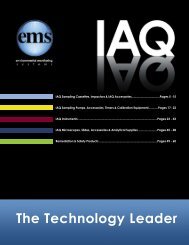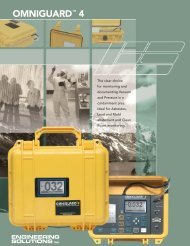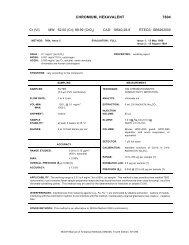NIOSH Method 7400 : Asbestos and Other Fibers by PCM
NIOSH Method 7400 : Asbestos and Other Fibers by PCM
NIOSH Method 7400 : Asbestos and Other Fibers by PCM
You also want an ePaper? Increase the reach of your titles
YUMPU automatically turns print PDFs into web optimized ePapers that Google loves.
ASBESTOS <strong>and</strong> OTHER FIBERS <strong>by</strong> <strong>PCM</strong>: METHOD <strong>7400</strong>, Issue 2, dated 15 August 1994 - Page 4 of 15to the action level (one-half the current st<strong>and</strong>ard), L (fibers/cc), of the fibrous aerosol beingsampled <strong>by</strong>:NOTE 1:NOTE 2:The purpose of adjusting sampling times is to obtain optimum fiber loading on thefilter. The collection efficiency does not appear to be a function of flow rate in therange of 0.5 to 16 L/min for asbestos fibers [7]. Relatively large diameter fibers (>3µm) may exhibit significant aspiration loss <strong>and</strong> inlet deposition. A sampling rate of 1to 4 L/min for 8 h is appropriate in atmospheres containing ca. 0.1 fiber/cc in theabsence of significant amounts of non-asbestos dust. Dusty atmospheres requiresmaller sample volumes ( ≤400 L) to obtain countable samples. In such cases takeshort, consecutive samples <strong>and</strong> average the results over the total collection time.For documenting episodic exposures, use high flow rates (7 to 16 L/min) overshorter sampling times. In relatively clean atmospheres, where targeted fiberconcentrations are much less than 0.1 fiber/cc, use larger sample volumes (3000 to10000 L) to achieve quantifiable loadings. Take care, however, not to overload thefilter with background dust. If ≥ 50% of the filter surface is covered with particles,the filter may be too overloaded to count <strong>and</strong> will bias the measured fiberconcentration.OSHA regulations specify a minimum sampling volume of 48 L for an excursionmeasurement, <strong>and</strong> a maximum sampling rate of 2.5 L/min [3].5. At the end of sampling, replace top cover <strong>and</strong> end plugs.6. Ship samples with conductive cowl attached in a rigid container with packing material to preventjostling or damage.NOTE: Do not use untreated polystyrene foam in shipping container because electrostaticforces may cause fiber loss from sample filter.SAMPLE PREPARATION:NOTE 1:NOTE 2:The object is to produce samples with a smooth (non-grainy) background in amedium with refractive index ≤1.46. This method collapses the filter for easierfocusing <strong>and</strong> produces permanent (1 - 10 years) mounts which are useful for qualitycontrol <strong>and</strong> interlaboratory comparison. The aluminum "hot block" or similar flashvaporization techniques may be used outside the laboratory [2]. <strong>Other</strong> mountingtechniques meeting the above criteria may also be used (e.g., the laboratory fumehood procedure for generating acetone vapor as described in <strong>Method</strong> <strong>7400</strong> -revision of 5/15/85, or the non-permanent field mounting technique used in P&CAM239 [3,7,8,9]). Unless the effective filtration area is known, determine the area <strong>and</strong>record the information referenced against the sample ID number [1,9,10,11].Excessive water in the acetone may slow the clearing of the filter, causing materialto be washed off the surface of the filter. Also, filters that have been exposed tohigh humidities prior to clearing may have a grainy background.7. Ensure that the glass slides <strong>and</strong> cover slips are free of dust <strong>and</strong> fibers.8. Adjust the rheostat to heat the "hot block" to ca. 70 °C [2].NOTE: If the "hot block" is not used in a fume hood, it must rest on a ceramic plate <strong>and</strong> beisolated from any surface susceptible to heat damage.9. Mount a wedge cut from the sample filter on a clean glass slide.a. Cut wedges of ca. 25% of the filter area with a curved-blade surgical steel knife using arocking motion to prevent tearing. Place wedge, dust side up, on slide.NOTE: Static electricity will usually keep the wedge on the slide.<strong>NIOSH</strong> Manual of Analytical <strong>Method</strong>s (NMAM), Fourth Edition, 8/15/94




